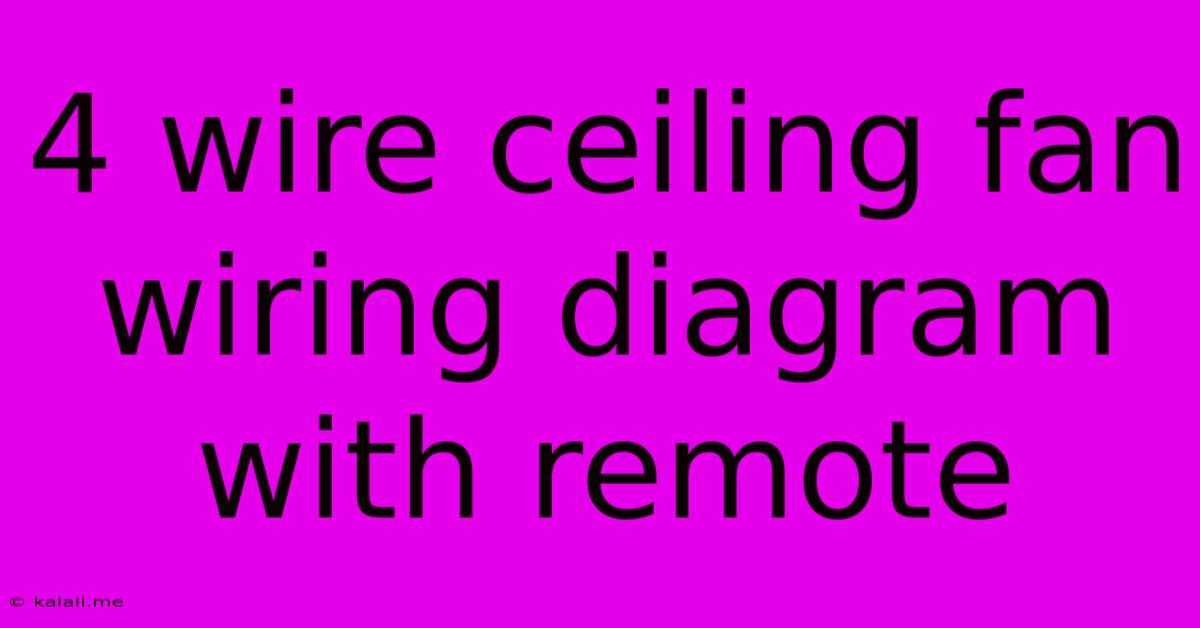4 Wire Ceiling Fan Wiring Diagram With Remote
Kalali
Jun 11, 2025 · 3 min read

Table of Contents
Decoding the 4-Wire Ceiling Fan Wiring Diagram with Remote: A Comprehensive Guide
This article provides a comprehensive guide to understanding and working with a 4-wire ceiling fan wiring diagram, specifically those incorporating a remote control. We'll break down the process step-by-step, addressing common questions and concerns. Understanding your ceiling fan's wiring is crucial for safe and effective installation and operation. This guide is designed for DIY enthusiasts but remember safety first – if you're uncomfortable working with electricity, call a qualified electrician.
Understanding the Four Wires
Before diving into the diagram, let's identify the four wires commonly found in ceiling fan installations:
- Black Wire (Hot): This carries the electrical power to the fan motor.
- White Wire (Neutral): This completes the electrical circuit and returns power to the source.
- Blue Wire (Light): This wire controls the fan's light kit (if applicable).
- Green/Bare Copper Wire (Ground): This crucial wire provides a path for electrical faults to ground, preventing electrical shocks.
The Wiring Diagram Explained
A typical 4-wire ceiling fan with a remote control uses a receiver to interpret signals from the remote and control the fan's speed and light. The receiver is usually housed within the fan's motor housing. Here's a simplified representation of the wiring connections:
- From the Ceiling: The black, white, and green wires from your home's wiring will connect directly to the corresponding wires of the fan. The blue wire from the ceiling connects to the blue wire on the fan's receiver.
- Within the Fan: The receiver’s internal wiring connects the incoming power and signals to control the motor speed and the light.
Note: Specific wiring configurations might vary slightly depending on the fan's brand and model. Always consult your fan's instruction manual for precise wiring instructions.
Common Wiring Scenarios and Troubleshooting
While the basic 4-wire setup is straightforward, variations exist. Here are some common scenarios and potential troubleshooting steps:
Scenario 1: Fan Works, Light Doesn't
- Check: Ensure the blue wire connections are secure both at the ceiling and within the fan's receiver. Test the bulb to ensure it's functioning.
- Possible Cause: Loose wire connections, faulty light bulb, or a problem with the fan’s light circuit.
Scenario 2: Remote Doesn't Control the Fan
- Check: Verify that the batteries in the remote are fresh. Ensure the receiver is correctly wired and connected. Check for any obstructions hindering the signal between the remote and the receiver.
- Possible Cause: Low or dead batteries, faulty remote, loose receiver wiring, or interference from other electronic devices.
Scenario 3: Fan Runs at only One Speed
- Check: Confirm that the remote is sending signals correctly. Inspect all wire connections. The capacitor inside the fan motor is also responsible for speed control and may be the source of the problem.
- Possible Cause: Faulty remote, malfunctioning speed control switch (if present), or a faulty motor capacitor.
Scenario 4: No Power to the Fan
- Check: Ensure the circuit breaker is not tripped. Check the power source at the ceiling junction box with a non-contact voltage tester (always prioritize safety!).
- Possible Cause: Tripped circuit breaker, faulty wiring in the ceiling junction box, or a problem with the house's electrical system.
Safety Precautions
- Turn off the power: Always disconnect power at the circuit breaker before working with any electrical wiring.
- Use the right tools: Utilize appropriate tools, such as wire strippers, pliers, and screwdrivers.
- Double-check your work: Carefully review all connections before turning the power back on.
- Seek professional help: If you're unsure about any aspect of the wiring process, don't hesitate to call a qualified electrician.
Understanding your ceiling fan's wiring diagram and taking the necessary safety precautions will ensure a safe and successful installation. By addressing common issues proactively and following these guidelines, you can confidently enjoy your new, remotely controlled ceiling fan. Remember to always consult your fan's specific instruction manual for detailed guidance.
Latest Posts
Latest Posts
-
Average Sat Score For Uc Irvine
Jun 12, 2025
-
Cardiac Muscles Differ From Skeletal Muscles In That They
Jun 12, 2025
-
Combinational Logic Circuits Questions And Answers Pdf
Jun 12, 2025
-
Action Words That Begin With K
Jun 12, 2025
-
Which Of The Following Is Insoluble In Water
Jun 12, 2025
Related Post
Thank you for visiting our website which covers about 4 Wire Ceiling Fan Wiring Diagram With Remote . We hope the information provided has been useful to you. Feel free to contact us if you have any questions or need further assistance. See you next time and don't miss to bookmark.